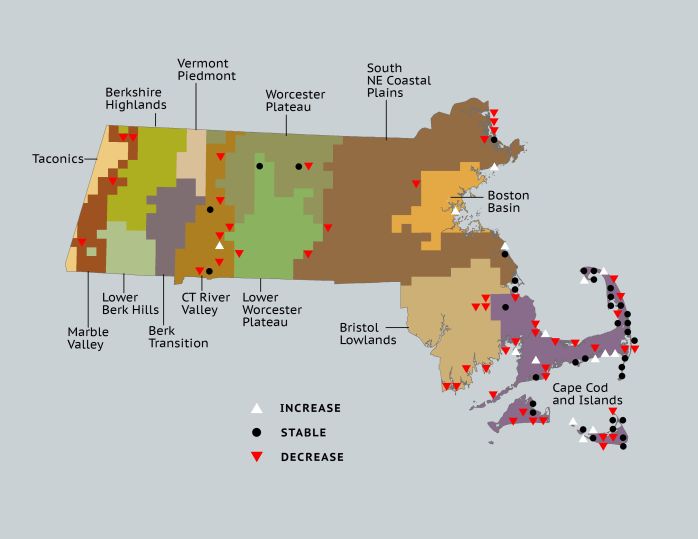Find a Bird
Horned Lark
Eremophila alpestris

Local and strongly declining
Conservation action urgent
“In Flanders fields the poppies blow / Between the crosses, row on row, / That mark our place; and in the sky / The larks, still bravely singing, fly / Scarce heard amid the guns below.” – John McCrae, “In Flanders Fields”
The squeaky, ascending song of the Horned Lark – America’s only true lark – is most often heard when the male takes to the air above a likely nest site, hoping to attract a female to accept him as her mate. The Horned Lark favors open and relatively barren habitat – the less vegetation, the better. High beach dunes with sparse dunegrass (Ammophila sp), particularly on the South Shore, Cape, and Islands, are the species’ preferred nesting habitat here in Massachusetts. Agricultural land and airfields also host Horned Larks, but sadly the age of intense farming in the Commonwealth is long gone, and with it many of the Horned Lark’s inland breeding sites.
Historic Status
The Horned Lark was known to the locals as the Shore Lark in the 1800s (Peabody 1839). One subspecies, the Northern Horned Lark, was always seen as a fall migrant that would stick around if the winter season proved mild enough (Peabody 1839). A second subspecies, the Prairie Horned Lark, first appeared in New England in 1891 (Sage et al. 1913). By 1910, as reported by state ornithologist Edward Howe Forbush, “The prairie horned lark appears to have extended its breeding range eastward. It now breeds not uncommonly in parts of Maine, New Hampshire, and Connecticut and also breeds in this State” (Forbush 1909). The Horned Lark’s arrival in Massachusetts as a breeding bird in the late 1800s proved to be nothing but a blip on the timeline of avian history. Reforestation of the state in the wake of retreating agriculture began to force the Horned Lark out of many breeding habitats within just a few decades.
Atlas 1 Distribution
During Atlas 1 Horned Larks were making a living at scattered locations inland, but their stringent habitat requirements meant that they were mostly coastal in distribution. The Marble Valleys had 10% Horned Lark occupancy, likely in areas of abandoned or fallow farmland. The Connecticut River Valley apparently had suitable breeding locations in 14% of the region, both in farm fields and at airports kept free of dense vegetation. Only a small scattering of occupied blocks bridged the gap from the Connecticut River Valley to the coast. The Coastal Plains had breeding Horned Larks on the beaches of Essex and Plymouth Counties, and the Bristol/Narragansett Lowlands reported several instances of inland breeding as well as nests found around the shores of Buzzards Bay. More than 60% of the species’ statewide distribution fell in Cape Cod and the Islands, where sandy dune habitat was readily available for Horned Larks looking to settle down.
Atlas 2 Distribution and Change
Within the three decades between Atlas 1 and Atlas 2, the Horned Lark began to opt out of Massachusetts as a breeding locality. Distribution patterns in Atlas 2 weakly mirror those of Atlas 1: up the Connecticut River, sparsely spread eastward, with the species’ most notable breeding strongholds in the southeastern Coastal Plains and on Cape Cod and the Islands. Horned Larks completely retreated from the far west and almost completely retreated from the Bristol/Narragansett Lowlands. The birds posted only a symbolic guard in Essex County, and even in their stronghold on Cape Cod and the Islands they disappeared from a dozen of the most well-surveyed blocks.
Atlas 1 Map

Atlas 2 Map

Atlas Change Map

Ecoregion Data
Atlas 1 | Atlas 2 | Change | ||||||
Ecoregion | # Blocks | % Blocks | % of Range | # Blocks | % Blocks | % of Range | Change in # Blocks | Change in % Blocks |
Taconic Mountains | 0 | 0.0 | 0.0 | 0 | 0.0 | 0.0 | 0 | 0.0 |
Marble Valleys/Housatonic Valley | 4 | 10.3 | 4.5 | 0 | 0.0 | 0.0 | -4 | -10.3 |
Berkshire Highlands | 0 | 0.0 | 0.0 | 0 | 0.0 | 0.0 | 0 | 0.0 |
Lower Berkshire Hills | 0 | 0.0 | 0.0 | 0 | 0.0 | 0.0 | 0 | 0.0 |
Vermont Piedmont | 0 | 0.0 | 0.0 | 0 | 0.0 | 0.0 | 0 | 0.0 |
Berkshire Transition | 0 | 0.0 | 0.0 | 0 | 0.0 | 0.0 | 0 | 0.0 |
Connecticut River Valley | 8 | 14.3 | 9.1 | 4 | 6.2 | 6.8 | -5 | -10.4 |
Worcester Plateau | 2 | 2.6 | 2.3 | 1 | 1.1 | 1.7 | -1 | -2.1 |
Lower Worcester Plateau | 2 | 2.7 | 2.3 | 1 | 1.3 | 1.7 | -1 | -1.9 |
S. New England Coastal Plains and Hills | 11 | 4.1 | 12.5 | 7 | 2.5 | 11.9 | -5 | -2.2 |
Boston Basin | 0 | 0.0 | 0.0 | 1 | 1.8 | 1.7 | 1 | 1.8 |
Bristol and Narragansett Lowlands | 8 | 7.5 | 9.1 | 1 | 0.9 | 1.7 | -8 | -7.9 |
Cape Cod and Islands | 53 | 39.0 | 60.2 | 44 | 30.6 | 74.6 | -12 | -10.0 |
Statewide Total | 88 | 9.1 | 100.0 | 59 | 5.7 | 100.0 | -35 | -4.2 |
Notes
The Horned Lark shows a significant decreasing Breeding Bird Survey trend in the Eastern US overall.



